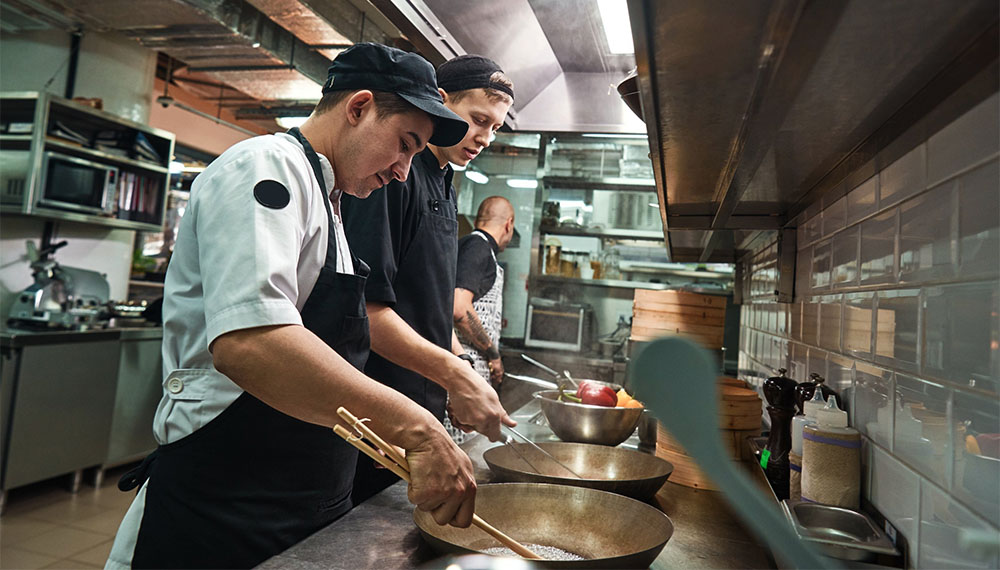Restaurant Staff Training: Tips, Tools and More
If you run a restaurant, you’ll know only too well the frustrations of trying to keep your team up to speed while, well, running a restaurant!
Employees who aren’t properly trained can lead to inconsistent service, lower morale, and even legal risks.
But the good news is, with the right strategies, tools, and a restaurant training program, you can turn staff training into a streamlined process that benefits both your business and your team.
This guide covers the key tips, tools, and best practices for effectively training your restaurant staff. Whether you want to improve efficiency or boost morale, you’ll find practical insights to help you manage training better.

Why training your restaurant employees is important
Training your restaurant staff isn’t just about teaching them the basics. It’s about helping them feel confident, work efficiently, and deliver great service every day. When your team is well-trained, everything runs more smoothly—from handling food safely to interacting with customers.
Proper training also makes a big difference in keeping your team around for the long run. When staff feel prepared and supported, they’re less likely to leave, reducing turnover and the costs that come with constantly hiring new people.
A well-trained team means happier customers, fewer mistakes, and a more productive restaurant overall.
You also have a legal obligation to train your team in the following areas:
Health and safety regulations
Staff need to be trained on food preparation and handling, cleaning procedures, and how to use equipment safely. Why? Because it protects your customers and your team.
Without proper training, you risk foodborne illnesses, accidents, and even health code violations. When your staff knows the rules, you build a culture of safety and care.
Labor laws
Do your staff know their rights? Do your managers understand the rules around wages, working hours, and breaks?
Training on topics like those, not to mention workplace harassment and discrimination, is essential for compliance, but also to ensure everyone feels safe and respected at work. By staying up to date with labor laws, you protect your team and your business.
Alcohol service
Responsible alcohol service is about more than just checking for fake IDs! Training programs ensure compliance and help your staff feel confident in tricky situations. Ongoing training keeps everyone sharp and prepared for any challenges that might come up.
Workplace certification requirements
Some roles in your restaurant require specific certifications, like Food Handler Cards or ServSafe certifications. Are you tracking who needs what and when renewals are due? This should be a key part of your training program.
Missing these can result in hefty fines or worse—so it’s essential to keep everything in check. Using a digital tracking system makes it easy to manage certifications and ensure compliance, creating a safer and more professional environment for everyone.

5 consequences of badly trained restaurant staff
When your staff aren’t trained properly, it can lead to all sorts of problems—some small; others big enough to put a real dent in your reputation. Here are five key consequences that can impact your restaurant, your customers, and your bottom line.
#1: Inconsistent customer service
Sluggish service, forgotten orders, and staff who seem befuddled by the simplest questions. We’ve all been on the end of it when it comes to untrained staff!
Customers notice. And before you know it, your restaurant’s reputation takes a hit. Poor service doesn’t just affect sales on the day—it can lead to fewer return customers and scathing reviews that can undo a lot of your (otherwise-good) work
#2: Safety violations
Food safety and workplace safety are non-negotiable.
When staff aren’t trained in these areas, mistakes happen—whether it’s mishandling food or unsafe practices in the kitchen. This can lead to accidents, illnesses, or even health code violations.
Safety violations can result in fines, bad inspections, or worst of all, harm to your employees or customers. Again, this is trust that it’s hard to win back. It is crucial that you provide appropriate restaurant safety training to your staff.
#3: High employee turnover
Do your staff feel unprepared for their roles? If so, they’re likely to leave.
High turnover puts extra stress on the team that stays, which can lead to burnout and even more people leaving. A vicious circle.
Constantly hiring and training new staff is expensive and time-consuming. Investing in proper training from the start helps reduce this cycle and keep your team stable.
#4: Legal liabilities
Missing out on training doesn’t just cause service issues—it can get you into legal trouble.
Whether it’s labor laws, health regulations, or alcohol service requirements, failing to comply with the law can lead to fines, license suspensions, or even lawsuits. Proper training helps you avoid these costly mistakes.
#5: Loss of revenue
At the end of the day, all these problems lead to one major consequence: lost revenue. Poor service, safety violations, high turnover, and legal issues all drain money from your business.
A well-trained team saves you money in the long run by improving restaurant efficiency, keeping customers happy, and avoiding penalties.
How to train restaurant staff
Identify must-have training
- Start by covering the basics—things like health and safety rules, labor laws, and any necessary certifications, such as food handling permits or alcohol service training.
- But don’t stop there. Make sure your staff also learns soft skills, like how to work as a team and handle customer interactions. These skills are just as important for keeping things running smoothly in your restaurant.

Craft a training plan for restaurant staff
- Every successful training program starts with a plan. Lay out clear steps and goals for what your team needs to learn, and set deadlines for when it should be completed.
- Have a centralized training platform available to everyone (ideally, mobile-friendly).
- Make sure you’re specific — each role, from servers to kitchen staff, should have a clear list of responsibilities and skills to master.
- Don’t forget to include your restaurant’s values in the plan so your staff knows what’s most important to your business.
Adopt a blended learning approach
- Not everyone learns the same way, right? That’s why it’s helpful to mix things up with both online and in-person training. For example, you can use video tutorials and online quizzes for basic knowledge, while hands-on practice and shadowing can help with real-world skills.
- Combining these two methods ensures your staff gets a well-rounded learning experience.
Schedule regular in person training refresher sessions
While a digital-based training plan for restaurant staff is a great tool, it should not be the only way you conduct necessary training. Have your managers or team leaders provide ongoing training face-to-face to update staff on new laws, procedures, or menu items.
This can also open up dialogue between your managers and staff. Why is this important? A staff member may spot something wrong with a current training procedure and raise it.
Offer role-specific restaurant employee training
- Every job in your restaurant requires different skills. You wouldn’t want your dishwasher taking orders, just like you wouldn’t expect your chef to greet customers with a smile. Every role has its expertise! By tailoring the training to each role, you’re giving your staff the tools they need to excel.
Run test shifts and simulations
- Want to see how your staff handles real-world pressure? Running test shifts or simulations is a great way to let them get their mistakes out of the way without the pressure of real customers.
Schedule regular in-person training refresher sessions
- Even after your staff has completed their initial training, don’t let it end there. Regular in-person refresher sessions are key to keeping skills sharp—whether it’s going over new menu items, updating safety protocols, or simply reinforcing good habits (Practice Makes Permanent!)
- These sessions are also a chance for your team to ask questions and discuss any challenges they’ve faced on the job.
Track and document training
Keeping track of who’s completed what training can be a headache.What happens if an inspector walks in, and you can’t immediately prove that your staff are trained and certified?
That’s a risk no restaurant should take. A digital system can help you easily log completed modules, certifications, and any necessary refreshers.
Gather restaurant training feedback
- How do you know if your training is effective? Simple—ask your staff! Gathering feedback after each training session helps you understand what’s working and where improvements are needed.
- You can use quick surveys or even just an informal chat to get their input. By doing this, you’ll be able to keep improving your training program.
Evaluate and update your restaurant staff training topics
A student is only as good as their master. Your staff are placed in the best position to perform well if they are trained with current material. It’s vital you regularly review and update the training for your restaurant employees to reflect changes in laws or industry best practices.
Incorporate technology training
- There’s not a part of modern life that technology doesn’t play a major role in, and the restaurant industry is no different. Make sure your team knows how to use key tools, like POS systems and payment terminals.
- Provide clear, easy-to-understand demonstrations, and keep training updated as new technology gets introduced.
5 top tips for training restaurant staff
Wondering how to get the best results from your training efforts? Here are some simple, effective tips to make sure your team is ready to deliver exceptional service every day.
Tip #1: Focus on communication and soft skills
Communication is key in any restaurant. Whether it’s greeting customers, handling complaints, or working together as a team, these skills can make or break the customer experience.
Why not try role-playing exercises? They’re a great way to help staff practice real-life situations in a safe, low-pressure environment.
Tip #2: Provide immediate feedback
Why wait until the end of a shift to give feedback when you can do it in real-time? Small adjustments during service can help staff improve on the spot.
Whether it’s reminding someone about hygiene or suggesting better ways to interact with customers, quick feedback helps everyone learn faster. Think of it as coaching—right when it matters most.
Tip #3: Keep product knowledge up to date
Are your staff confident in talking about your menu? Knowing the ins and outs of your dishes helps them upsell with confidence.
Regular product knowledge training—like tasting sessions or quick quizzes—ensures your team can answer customer questions, make recommendations, and boost sales. After all, a well-informed team is a confident team.
Tip #4: Make cleanliness a priority
Regularly remind staff about handwashing, sanitizing, and food safety. Short refresher sessions are great for keeping everyone on the same page, especially during busy shifts.
When your team knows how to prioritize cleanliness, your customers will notice—and appreciate it.
Tip #5: Encourage peer learning
Pairing new hires with experienced employees for mentorship can speed up the learning process. It’s also a great way to build relationships within your team and ensure everyone’s learning the same standards.
Peer learning helps create a supportive environment where everyone shares their knowledge.
How to create a restaurant training manual
A restaurant training manual (or a restaurant SOP) is your blueprint for ensuring consistency and quality across your team. It helps every employee understand the key procedures, values, and expectations that keep your business running smoothly.
So, how do you create an effective one?
Start by organizing the manual into clear sections. These sections should cover the essential areas of your restaurant’s operations:
- Introduction and overview: Include your restaurant’s mission, values, and history. This helps set the tone for new employees and gives them insight into what your business stands for.
- Job descriptions and responsibilities: Outline the specific duties for each role—servers, cooks, hosts, and managers—so that employees know exactly what’s expected of them.
- Health and safety protocols: Detail the food safety practices, cleaning procedures, and emergency protocols to ensure a safe working environment for both staff and customers.
- Customer service standards: Include guidelines on greeting customers, handling complaints, and delivering top-notch service. Role-play examples can be super helpful for training.
- Operational procedures: Break down day-to-day tasks such as opening and closing duties, cash handling, and inventory management.
- Technology and equipment: Provide instructions for using the POS system, kitchen equipment, and other technology used in your restaurant.
Remember to keep the language simple and use bullet points, diagrams, or flowcharts to make the manual easy to follow. Regularly update the content to reflect any changes in restaurant policies or procedures.
Lastly, make the manual accessible to everyone. Consider providing a digital version that staff can easily access from their phones or tablets. This ensures that employees can refer back to the manual whenever they need guidance.
5 tools and software for training restaurant staff
Effective restaurant staff training doesn’t just happen on its own—it requires the right tools to make sure your team is well-prepared and confident in their roles. From digital training platforms to mobile apps, there are plenty of solutions that can streamline the process and make it easier to manage. Below are five tools designed to help you train your restaurant staff efficiently.
#1: Operandio
Operandio is the perfect all-in-one solution for training and managing your restaurant staff. It offers mobile-first training modules that your team can access anytime, anywhere. Whether it’s tracking certifications, running training sessions and quizzes, or monitoring employee progress, Operandio simplifies everything. Our workforce training software also allows you to customize for different roles, so everyone gets the training they need to succeed.
#2: Trainual
Trainual lets you create custom training materials, track employee progress, and add video tutorials for hands-on learning. You can also update it as your restaurant grows, so your training stays fresh and relevant.
But, Trainual has its downsides, like missing some key features, and when you look into Trainual pricing, it may not fit every restaurant’s budget.
For that reason, you may want to explore Trainual alternatives.
#3: TalentLMS
TalentLMS is a learning management system that allows you to create courses tailored to your team’s needs. Whether you’re training servers, kitchen staff, or managers, this platform offers a range of tools like quizzes, certifications, and progress tracking to keep everyone on track.
#4: 7shifts
7shifts is a workforce management tool designed specifically for restaurants. In addition to scheduling, it also provides training features like employee onboarding and document storage.
#5: Schoox
Schoox offers a flexible, cloud-based solution for training your staff. You can build courses that cover everything from health and safety to customer service, and track progress through its dashboard.
How Operandio’s compliance software makes restaurant staff training simple
Operandio helps you manage all training materials and records in one place, making it easy to track employee progress and certification statuses.
It can automatically send you reminders for upcoming training, ensuring nothing is missed. You can customize training programs for different roles in your restaurant, allowing staff to access relevant modules.
The software also generates reports for audits or inspections and makes it easy to show proof of compliance. Additionally, it monitors employee engagement with training, ensuring accountability through progress tracking and completion certificates. Book your free demo today and witness firsthand all of the innovative ways Operandio can simplify help you when it comes to training your restaurant employees.


